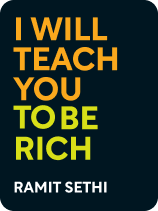

This article is an excerpt from the Shortform book guide to "I Will Teach You to Be Rich" by Ramit Sethi. Shortform has the world's best summaries and analyses of books you should be reading.
Like this article? Sign up for a free trial here .
Do you have to be rich to invest? How much money do you need to get started?
According to financial educator Ramit Sethi, investing isn’t just for the wealthy—even minimum-wage earners can start investing if they get to grips with their finances. In his book I Will Teach You to Be Rich, Sethi provides a six-step investing roadmap to help you get started on your investing journey, no matter your current income.
Keep reading for Ramit Sethi’s six-step process for getting started with investing.
Ramit Sethi: 6-Step Investing Roadmap
Ramit Sethi’s investing roadmap consists of six steps:
- Step 1: Take advantage of your employer’s 401(k) match.
- Step 2: Get rid of credit card debt
- Step 3: Open a Roth IRA.
- Step 4: Max out your 401(k).
- Step 5: Find out if you’re eligible for an HSA.
- Step 6: Open a regular taxable investment account and fund it.
In the next sections, we’ll cover the 401(k), Roth IRA, and HSA accounts in more depth. As you read, keep in mind that investing through these accounts requires two steps: funding the account and actually investing the money in it. Many people end up not investing at all because they mistakenly assume their money is automatically invested once they set up automatic transfers into their 401(k) or Roth IRA. That can be a costly mistake: If you pour money into your account but never actually invest it, it will just sit there without earning any returns. In this chapter, we’re only going to focus on opening the accounts and funding them—we’ll get to the actual investing in Chapter 7.
Start With Your 401(k)
A 401(k) is an investment account sponsored by many employers to help their employees save for retirement. When you open a 401(k) account, you authorize your employer to send a certain amount out of each paycheck into that account automatically. The money in your 401(k) isn’t automatically invested—you’ll have to actively decide where to invest it (we’ll cover that in detail in Chapter 7). A 401(k) is one of the best retirement investment accounts out there for three major reasons.
1. The money in your 401(k) is “pretax,” which means it isn’t taxed until you withdraw it. That means your contributions will be much bigger (because they haven’t had taxes taken out of them yet), meaning your principal investment amount is higher, which can increase the compound growth of your investments by 25 to 40%. You’ll have to pay taxes on the money when you withdraw it, but because of compound interest, you’ll still come out ahead compared to a regular investment account (where you invest money that has already been taxed).
2. Your employer might match your contribution. That means that every time you funnel money into your 401(k) account, your employer will “match” that contribution up to a certain percentage of your salary. For example, if your employer has a one-to-one matching policy up to 5% of your salary, that means that if you contribute 5% of your salary, your employer will double that contribution. In other words, this is free money. To see how big a difference this makes, look at the table below to see how a 401(k) account grows over time, with and without matching (assuming 8% returns).
| Age | Account balance without matching | Account balance with matching |
| 35 | $3,240 | $6,480 |
| 40 | $19,007 | $38,016 |
| 45 | $46,936 | $93,873 |
| 50 | $87,973 | $175,946 |
| 55 | $148,269 | $296,538 |
| 60 | $236,863 | $473,726 |
| 65 | $367,038 | $734,075 |
3. You’ll invest automatically, without even knowing it. Your 401(k) contributions come out of your paycheck before you get paid, so you won’t have to worry about investing it yourself—it’s already taken care of by the time you get paid each month.
There is one downside to a 401(k): If you withdraw your money before age 59.5, you’ll incur a 10% early withdrawal penalty in addition to paying income tax on the money. Basically, your 401(k) is exclusively for long-term investing, so you should avoid withdrawing the money early unless you’re absolutely desperate.
(If your employer doesn’t offer a 401(k), don’t worry! In the next section we’ll learn how to set up a Roth IRA, which is a different type of tax-advantaged retirement account open to everyone below a certain income level. And if you’re self-employed, look into Solo 401(k) and SEP-IRA accounts, which function similarly to a traditional 401(k) for people who don’t work for a traditional employer.)
If You Change Jobs
If you get a new job, you won’t lose your 401(k) money—but because the account itself is sponsored by your old employer, you’ll have to move that money somewhere else. There are a few different ways to do this:
- The best option is to “roll over” the money from your 401(k) into an IRA. Once the money is in an IRA, you’ll have more control over where to invest it (because 401(k) investment options are usually very limited). A brokerage firm can help you transfer the money into an IRA for free.
- You could also roll the money in your existing 401(k) over to your new company’s 401(k). The problem with this is that if you use that money to fund your new 401(k), those contributions won’t be eligible for employer match, so you lose out on the main benefits of a 401(k).
- You could leave your 401(k) where it is. This is dangerous—it’s easy to forget about an old 401(k) and end up letting your money stagnate.
- Finally, you could cash the money out and pay the hefty early-withdrawal penalties—but you’ll lose a lot of money this way!
Roth IRAs
Once you’ve set up your 401(k) (or if your employer doesn’t offer one), it’s time to set up a Roth IRA. This is another type of retirement account, but unlike a 401(k), you don’t need an employer to sponsor it (and there’s no employer match option). Roth IRAs also allow you to invest however you want rather than making you choose between a few pre-selected funds like a 401(k).
The other major difference between a Roth IRA and a 401(k) is that the money you invest in your Roth IRA has already been taxed—which means that you’ll pay taxes on the money you put in, but you’ll pay no taxes on the money you earn on top of that. That gives you a huge benefit over a regular, taxable investment account, in which you pay taxes on both your contributions and your returns.
- The more you contribute to your Roth IRA, the more you capitalize on that tax benefit. For example, if you contribute $5,000 per year for 30 years (assuming an 8% annual return and 25% tax rate), you’ll earn almost $200,000 more in a Roth IRA than in a taxable investment account.
Another benefit to Roth IRAs is that it’s easier to access your money than with a 401(k): You can withdraw the money you’ve personally contributed to your Roth IRA account at any time, penalty-free. However, you’ll face penalties if you withdraw the money you’ve earned on top of that principal before the age of 59.5. There are exceptions to this rule—you won’t face penalties if you withdraw your earnings to pay for education, emergencies, buying a home, or other similar expenses. However, these exceptions are only available if your account has been open for at least five years, which is one reason why it’s so important to open your account sooner rather than later!
Contribution and Income Restrictions
There are two major restrictions on Roth IRA accounts. The first is a maximum yearly contribution, or how much you can add to the account out of your own pocket every year. The exact amount changes each year, so search “Roth IRA contribution limits” to find the current maximum.
The second restriction is a maximum income limit. To open a Roth IRA, your income can’t exceed a certain maximum limit (this number also changes every year, so search “Roth IRA income limits” to find the current numbers). If your income is below the maximum but still higher than average, you can open a Roth IRA, but the maximum yearly contribution you’re allowed to make decreases.
- If your income is too high for a Roth IRA, you can still get after-tax benefits by opening a Roth 401(k), if your employer offers one. These accounts offer the best of both worlds: the after-tax benefits of a Roth IRA (without the income restrictions), and the employer-match benefits of a traditional 401(k). Roth 401(k) accounts are a good option if you expect to be in a higher tax bracket when you retire than you are now, because the money won’t be taxed when you withdraw it like it would be with a traditional 401(k).
Choosing a Brokerage Firm
To open a Roth IRA, you’ll need an account with an investment brokerage. For now, you want to focus on discount brokerages, which offer nearly all the same features as “full service” companies (like Morgan Stanley) but with much smaller minimum investing fees, usually between $0 and $3,000. (Remember, that’s how much money you’ll need before you can actually invest the money in your account. Opening the account itself is always free.) Most brokerages will even waive those minimums if you set up automatic monthly transfers. Here are the top three discount brokerages Sethi recommends.
- Vanguard. This is the company Sethi personally uses for his investments because they offer low-cost funds to invest in. Vanguard charges a $1,000 minimum to start investing with their Roth IRAs. You won’t be able to get this one waived (even with automatic monthly contributions), so if you don’t have $1,000 to invest yet, set it as a savings goal.
- Schwab. If you opted to open a Schwab Investor Checking account back in Chapter 2, you already have a Schwab brokerage account linked to your checking account automatically. The minimum to invest in your Roth IRA through this account is $1,000, but Schwab will waive that minimum if you set up a $100 automatic monthly contribution.
- Fidelity. Fidelity is unique because they have zero minimums, so you can invest however much you like, but the fund options they offer to invest in typically have higher fees than Vanguard’s.
Robo-Advisors
In addition to the discount brokerages above, you now have the option to invest with “robo-advisors” like Wealthfront and Betterment, which are brokerages that use computer algorithms rather than human financial advisors to help you invest your money. These companies typically have a sleek user interface that appeals to younger people, and they even allow you to add your financial goals (like saving for a down payment on a house) and automatically allocate some of your returns to them.
For most people, robo-advisors are a good, low-fee option to get started with investing. However, there are downsides to investing with robo-advisors compared to traditional discount brokerages like Vanguard. Robo-advisors are a relatively new technology, which means they have far fewer customers and manage far less wealth than companies like Vanguard, who have been around much longer. In practice, that means that robo-advisors may not be able to sustain the low fees they currently offer unless they significantly increase their customer base—so there’s a risk of their fees rising in the future. For example, Wealthfront already faced a small scandal when it introduced a higher-cost fund and automatically enrolled some customers in that fund without their knowledge.
Sethi personally recommends traditional discount brokerages like Vanguard over robo-advisors, but if the ease and accessibility of robo-advisors appeals to you, they’re still a solid option. Do your research, but don’t agonize too much over this decision—remember, the fact that you’re investing at all is far more important than the specific company you use to do it.
Health Savings Accounts (HSAs)
Once you’ve started investing in your 401(k) and Roth IRA, you can also look into investing through a Health Savings Account (HSA). These are tax-advantaged accounts that are only available to people who have high-deductible health insurance plans. HSAs are designed to help you save for qualified health expenses, like insurance deductibles, copayments, and prescriptions. There are two major benefits to using an HSA: tax-free health spending and tax-free retirement investing.
Tax-Free Health Spending
Although HSAs are technically a form of savings account, they function more like a checking account: Once you open the account and fund it, you’ll get a debit card you can use to pay for medical expenses using the money in your HSA. The benefit of paying for those expenses with an HSA instead of with your checking account or credit card is that the money in an HSA is tax-free. That means you can spend that money without ever paying income taxes on it, which will save you at least 20%, if not more.
Tax-Free Retirement Investing
The other major benefit of using an HSA rather than a typical savings account is that you can invest the money you set aside in an HSA into the stock market, which means that any money you don’t use for health expenses can earn much higher returns than the interest it would earn in a typical savings account.
Like 401(k)s and Roth IRAs, you’ll only get the tax benefits of investing in an HSA if you wait to withdraw that money until you reach retirement age (in this case, age 65, rather than age 59.5 for other retirement accounts)—and if you withdraw the money for anything other than health expenses before that point, you’ll face a penalty. However, as a reward for your long-term investing, you won’t pay income taxes on the money you contribute to your HSA or on the returns you earn from investing that money. On top of all that, contributing to an HSA qualifies you for a tax deduction, making it a triple threat of tax benefits (some people even pay for health expenses out of pocket and invest all the money in their HSA to maximize those benefits).
After you turn 65, you can keep using the money in your HSA to pay for health expenses, tax-free. At that point, you can also withdraw it for any non-health-related expenses without paying a penalty (although you will have to pay taxes on the money you withdraw).
Investment Account Action Items
- Open your 401(k). To get started, talk to the human resources administrator at your company. As you’re filling out the forms, hold off on choosing which specific funds to invest in for now (we’ll cover different kinds of funds in depth in Chapter 7). If your company offers employer matching, proceed to the next action item; if not, open the 401(k) account but hold off on funding it until you’ve maxed out your Roth IRA.
- Calculate your 401(k) contribution to take full advantage of employer match (remember, if your employer offers a 5% match, you want to contribute a full 5% of your yearly salary to get the full benefits of that match). When you open your 401(k) account, you’ll be able to specify how much of each paycheck you want automatically sent to your 401(k). To figure out how much to contribute, multiply your yearly salary by the employer match percentage your company offers, then divide that amount by 12 months (if you get paid biweekly rather than monthly, divide by 24 instead).
- For example, If you make $50,000 per year, 5% of income is $2,500 per year. Divided monthly, that’s a contribution of $208 per month. If you can’t afford to lose $208 per month out of your paycheck, you can scale this back, but try to get as close as you can to the full match.
- Open a Roth IRA and set up automatic monthly contributions. Here’s how to do this:
- First, spend some time researching the discount brokerages and robo-advisors.
- Once you find one that fits your needs and lifestyle, open an “investment brokerage account” with that company. This will be the general account that houses your more specific investment accounts (like a Roth IRA).
- Next, open a Roth IRA through your investment brokerage account using the instructions on your brokerage account’s website (opening the account is free).
- Last, set up automatic monthly contributions from your checking account into your Roth IRA. If you’re investing through Schwab, these need to be at least $100 per month—otherwise, pick a number you’re comfortable with for now (you can adjust it up or down later depending on the expenditure plan you’ll develop in Chapter 4).
- If you have money left over to invest, max out your 401(k) contribution. Right now, you’re probably investing just enough into your 401(k) to get your full employer match, but you can invest even more—up to the maximum yearly contribution—to take advantage of the tax benefits of a 401(k). That maximum only includes your own contributions, not your employer match.
- For example, in 2019, the maximum yearly 401(k) contribution was $19,000. If you currently contribute $5,000 per year and your employer matches that with another $5,000, you’d have a total of $10,000 in your 401(k). But if you max out your personal contribution with another $14,000 (bringing your total contribution to the maximum of $19,000), you’d have a total of $24,000 in your 401(k).
Open an HSA (if you’re eligible). Call your health insurance company to find out if you have a “high deductible health plan.” If they say yes, ask them if you can pair that plan with an HSA (and if they say no, ask if you’re eligible for a high deductible plan). If so, research the different HSAs available, find one you like, and open the account.

———End of Preview———
Like what you just read? Read the rest of the world's best book summary and analysis of Ramit Sethi's "I Will Teach You to Be Rich" at Shortform .
Here's what you'll find in our full I Will Teach You to Be Rich summary :
- The small steps you can take towards living a "rich life"
- How to choose the right bank account and manage your credit cards
- How to create a financial system that grows your money automatically






